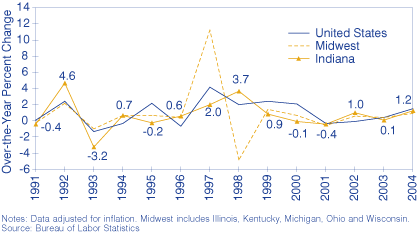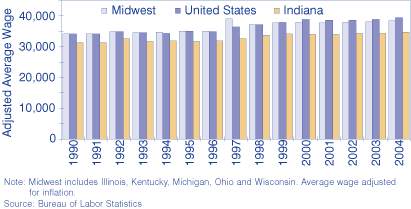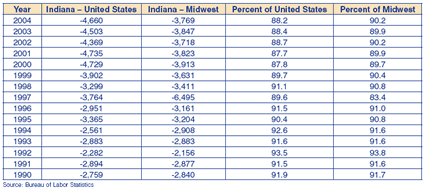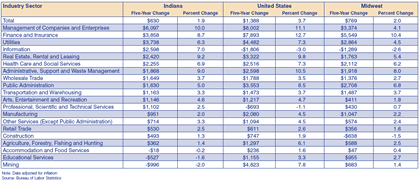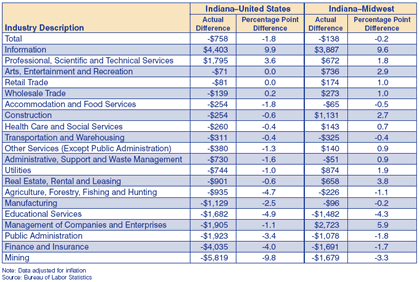Average Annual Pay Comparison
While the rate of average annual pay growth in the past has fluctuated among regions, more recently the rate of growth has aligned for the United States, Midwest and Indiana, according to the Bureau of Labor Statistics. Indiana experienced a 1.2 percent increase in pay from 2003 to 2004, less than the United States but greater than the Midwest (see Figure 1). The 11.3 percent increase in average annual pay for the Midwest in 1997 was mainly due to Michigan's 47 percent increase in wages that dropped back down the following year. Indiana's largest increase was in 1992, when average annual pay grew 4.6 percent. Even though Indiana's growth rates are not far from the rest of the nation and the Midwest, at $34,694, Hoosiers are paid $4,660 dollars less than others across the nation and $3,769 dollars less than other workers across the Midwest (see Figure 2). This stubborn pay gap has widened over the last decade (see Table 1).
Figure 1: Over-the-Year Percent Change in Average Annual Pay, 1991 to 2004
Figure 2: Adjusted Average Wage, 1990 to 2004
Table 1: Difference in Average Annual Pay
Five-Year Change in Average Annual Pay
Examining our position from 1999 in relation to 2004, our pay level eroded relative to the Midwest and the rest of the nation. Which sectors contributed the most to this loss of ground? Table 2 shows the change in average annual pay, while Table 3 shows the differences between Indiana and other regions. Indiana saw pay decreases in three industries: accommodation and food services, educational services, and mining. Both the United States and the Midwest saw a decline in average annual pay for the information sector, while Indiana experienced a 7 percent increase ($2,598). An increase of this magnitude is certainly welcomed but should not overshadow the fact that the state's average annual pay in this sector is $19,391 less than the United States and $8,299 less than what other Midwestern workers earn in this sector. Indiana's five-year change in pay was only greater than the United States in the information sector and the professional, scientific and technical services sector. However, Indiana had larger average annual pay increases than the Midwest in 11 out of 20 sectors. The five-year change in pay for all industries combined was $758 less than the United States and $138 less than the Midwest.
Table 2: Five-Year Change in Average Annual Pay, 1999 to 2004
Table 3: Difference in Five-Year Average Annual Pay, 1999 to 2004
Overall, only 25 counties saw dollar declines in their average annual pay over the five-year period. As shown in Figure 3, Vermillion County had the largest average annual pay decline ($4,863, -11.6 percent). Gibson County workers saw the largest increase in their inflation-adjusted average annual pay ($11,579, 37.9 percent).
Figure 3: Five-Year Change in Average Annual Pay
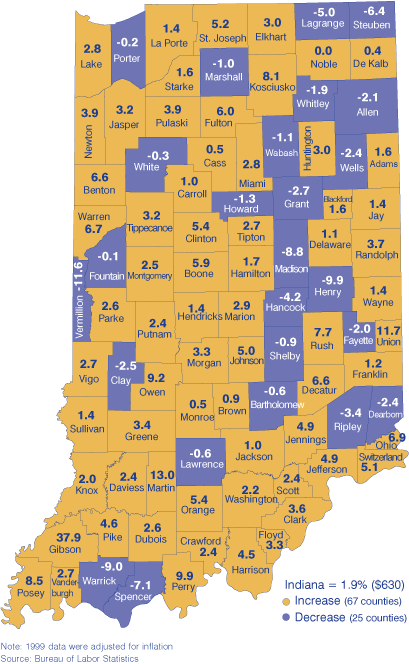
In 2004, the average annual pay levels in Indiana were lower than the nation and the Midwest in all sectors except agriculture, forestry, fishing and hunting and in the arts, entertainment and recreation (Midwest only). Of course, average annual pay is not what you actually get to bring home, and cost of living cannot be ignored when comparing pay levels between areas.
The Bureau of Economic Analysis provides per capita disposable personal income for states for this time period. Although this calculation is based off of personal income, which includes all sources of income and not just work-related income, this can give us an idea of the cost of living for Indiana residents. Note that per capita disposable personal income is personal income from all sources minus taxes which includes income, property tax and motor vehicle licensing. In 2004, Indiana's disposable per capita personal income was $27,070, an increase of 7.5 percent since 1999. Indiana's disposable per capita personal income growth rate was 0.9 percentage points less than the nation, 1.6 percentage points greater than Illinois and 1.9 percentage points greater than Ohio and Michigan. Per capita disposable personal income in Wisconsin and Kentucky grew faster than in Indiana over this five-year period (0.7 and 0.9 percentage points, respectively). So the fact that Indiana's disposable per capita personal income has grown faster than some of its Midwestern neighbors between 1999 and 2004 helps to offset the $138 difference in the change in average annual pay. The October issue of InContext found that housing is very affordable for Hoosiers, both homeowners and renters, relative to the rest of the nation (owners' costs in the article included the cost of utilities). Housing and utilities are two variables often looked at when examining the cost of living.
Notes
- The Bureau of Labor Statistics admits this may be an anomaly in the reconstructed data series.
Amber Kostelac, Data Manager
Indiana Business Research Center,
Kelley School of Business, Indiana University

